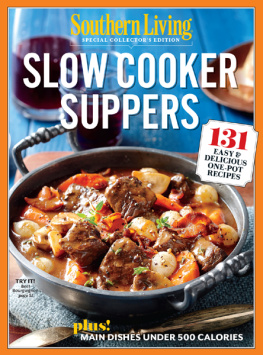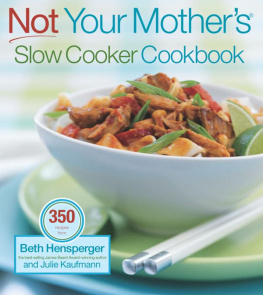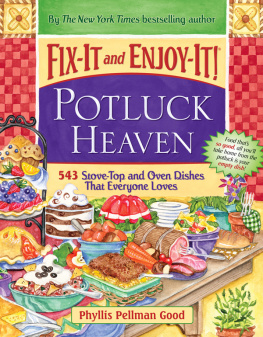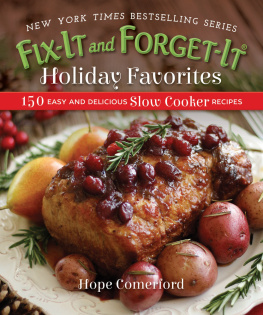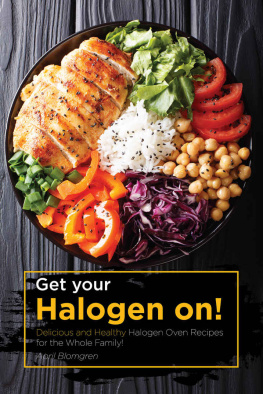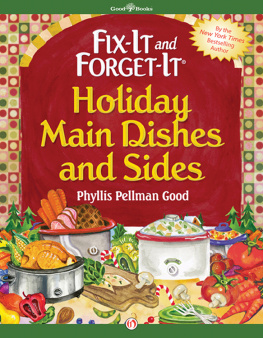


contents
introduction
This is a book I did not expect to write. Single and living in a New York City apartment, I used my freezer primarily for storing nuts, exotic rices, vodka, and fruit for smoothies. Only those with a family to feed would, I assumed, fill it with prepared dishes, and that would require a real freezer, or at least a prestige-brand refrigerator with more freezer capacity than the modest compartment on top of my 15-year-old Magic Chef fridge.
Then I became a caregiver. Looking after aging parents soon had me cooking for three rather than just myself. After a chaotic few weeks of running back and forth to give them freshly prepared meals at least once a day, I started stocking my freezer with soups and one-dish meals in individual servings that I delivered to them once a week. This allowed my folks to heat up ready-to-eat meals every day on their own, and I got to control when I cooked. Using the freezer reduced stress and even made cooking time pleasant.
Still, I rarely thought to use the freezer for myself. Only while creating the recipes for a Mediterranean cookbook did I get interested in storing prepared food long term. Because I was cooking several delicious dishes a day, there was more than I could possibly eat. I gave some food away but began freezing the dishes I liked best. Weeks later, after the book was completed and I needed time off from cooking, I turned to my well-stocked freezer. What emerged was a revelation. Mostly, the soups and stews were fine, but the thawed rice in the paella was a mushy disaster, while other dishes turned watery. Gazpacho that went in tasting good was overpowered by garlic and full of soggy vegetables when defrosted.
These spectacularly varied results started a research phase during which I discovered what kind of recipes produced meals that were great both when freshly cooked and when defrosted. As I experimented with methods and ingredients, I developed a natural replacement that duplicates the canned condensed soups called for in casseroles and an apple pie you would never know came from the freezer. I also found out how to streamline the work of preparing several dishes during one afternoon or evening.
Now my freezer, which is less than 24 inches wide and only 11 inches high, holds several batches of soup, layers and frosting for a chocolate cake, a couple of stews, sloppy joes, lasagna, burritos, chocolate chip cookie dough, and rosemary-roasted almonds. Guests never know whether the dishes I serve them are freshly prepared or came from the freezer. Plus, when work deadlines have me on overload, I eat very well without ordering budget-busting takeout or buying frozen entrees. In fact, I shop the supermarket for specials and save money by packing the freezer.
A well-stocked freezer provides multiple benefits. It can help parents, professionals, students, singles, and older people with busy lives meet mealtime effortlessly. You will know the meals you serve your family, a partner, or yourself are good because you made them. You are certain they contain only the best fresh ingredients, were made safely, and meet any special dietary needs. Plus, cooking to freeze can do more than fit your budgetit can help you trim it while eating fabulously.
If this sounds good, I hope that using this book, you will join me in serving meals that prove convenience need not compromise quality. Drawing raves whether served freshly made or out of the freezer, the recipes in this book include dishes for casual dinners, quick hors doeuvres, sweet treats, hearty soups, and even elegant dishes to serve by candlelight.
chapter 1
everything you need to know
Serving dishes from the freezer saves time and money. Doing it successfully depends on what you make and how you store, defrost, and reheat it.
Not all dishes freeze equally well or should be handled the same way after freezing. I have experimented to find what works best. The result is dishes that win raves when you serve them immediately and are still delicious when you serve them from the freezer. To assure this, the recipes in this book include directions for each stepfrom freezing and defrosting to reheatingthat are perfected for each dish. As a result, your Double Chocolate Layer Cake and other baked goods will remain moist when the freezer wants to dry them out. Soups and stews will have lively flavors, meats will stay tender, and vegetables will remain appealing when reheated.
This book also includes many casseroles, which are freezer favorites, in recipes that offer a unique choice. When condensed soup is called for, you have the option to replace it with a homemade and natural equivalent. These creamy souper sauces I have created also happen to be gluten-free.
how freezing works
As foods freeze, the water in the cells of vegetables, meats, and other foods turns to ice crystals. The ice preserves food by slowing down deterioration caused by microorganisms, including bacteria, that leads to decay. These microorganisms must have water to function. Turning the water to ice prevents them from growing and creating reactions that make food spoil. It is important to note that depriving microorganisms of water does not kill them. This means food must be kept solidly frozen at 0F or lower to be safely preserved.
The more quickly foods freeze, the smaller the ice crystals that form. Compare serving grainy refrozen ice cream to the creamy original and you will see why the smallest crystals are desirable. Fine ice crystals maintain better flavor, as well, because they do not rupture cell walls. As food defrosts, the ruptured cells collapse and moisture flows out. Think of the watery collapse of a defrosted strawberry and youll have a good picture of the effect of ruptured cells.
freeze fast
To store food properly, your freezer needs to be at 0F, and even colder when you are adding food to be frozen. Most freezers have a thermostat dial you can turn down. Others have a fast freeze function to switch on when adding foods to freeze. Once the new items are frozen, you can return the freezer to around 0F. A freezer thermometer helps you make sure the freezer is reaching and maintaining the proper temperature and costs $20 or less. I like Mavericks RF-02 digital refrigerator/freezer thermometer for a combination refrigerator/freezer or Taylors thermometers for freezers.
air is the enemy
When air reaches frozen food, it causes freezer burn, gray patches that are hard and tough. Food with freezer burn is dry and off-tasting. The air can be from the outside or inside. Air pockets in a container of frozen soup, for example, allow big ice crystals to form and then evaporate, causing freezer burn. Sealing food airtight requires both the right packaging and good technique.
freezing is not forever
While freezing preserves foods, they still deteriorate over time. We have all heard about a roast that languished in the freezer for years. If it was not covered with freezer burn and was still edible, odds are it tasted like a defrosted ice cube.
Since flavors fade long before frozen food becomes inedible, the storage times I recommend are the result of checking dishes after different amounts of time in the freezer. Stored longer, they absolutely will be edible; however, they just will no longer have maximum flavor and optimum texture.
Next page

